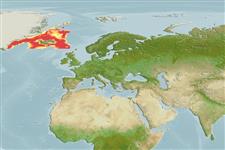Environment: milieu / climate zone / depth range / distribution range
Ecología
marino batidemersal; rango de profundidad 100 - 1800 m (Ref. 58496). Deep-water
Distribución
Países | Áreas FAO | Ecosistemas | Ocurrencias, apariciones | Point map | Introducciones | Faunafri
Northeast Atlantic: East Greenland, Faeroes Islands and Iceland.
Tamaño / Peso / Age
Maturity: Lm ? range ? - ? cm
Max length : 8.2 cm SL macho / no sexado; (Ref. )
Maximum depth reported at 1800 m (Ref. 9925). Max length from specimen in original description.
Life cycle and mating behavior
Madurez | Reproducción | Puesta | Huevos | Fecundidad | Larva
Nielsen, J.G. and E. Bertelsen, 1992. Fisk i grønlandske farvande. Atuakkiorfik, Nuuk. 65 s. (Ref. 9925)
IUCN Red List Status (Ref. 130435: Version 2024-2)
Threat to humans
Harmless
Human uses
Pesquerías: sin interés
Herramientas
Special reports
Download XML
Fuentes de Internet
Estimates based on models
Preferred temperature (Ref.
123201): 0.3 - 7.6, mean 3.4 °C (based on 189 cells).
Phylogenetic diversity index (Ref.
82804): PD
50 = 0.5000 [Uniqueness, from 0.5 = low to 2.0 = high].
Bayesian length-weight: a=0.00457 (0.00208 - 0.01002), b=3.17 (2.99 - 3.35), in cm total length, based on LWR estimates for this Genus-body shape (Ref.
93245).
Nivel trófico (Ref.
69278): 3.2 ±0.5 se; based on size and trophs of closest relatives
Resiliencia (Ref.
120179): Bajo, población duplicada en un tiempo mínimo de 4.5-14 años (Fecundity assumed < 100).
Fishing Vulnerability (Ref.
59153): Low vulnerability (10 of 100).
